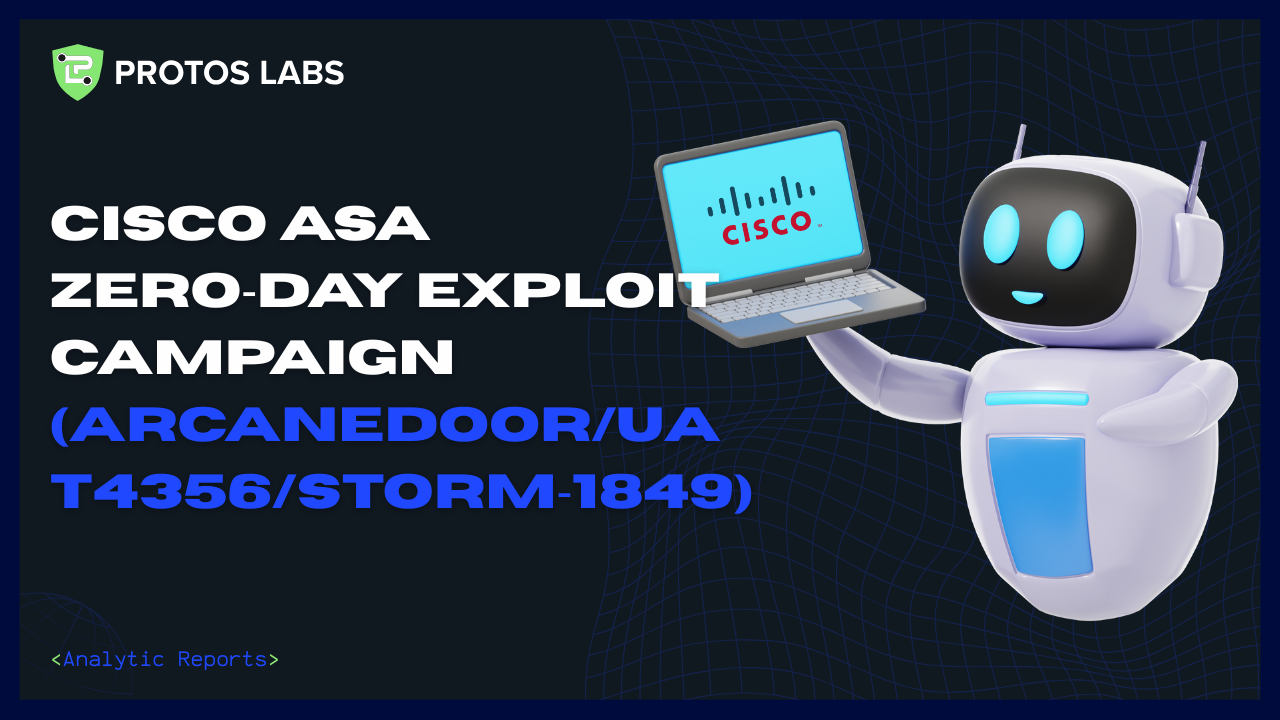Executive Summary
A likely state‑sponsored actor is exploiting multiple zero‑day vulnerabilities in Cisco ASA and FTD devices, in activity aligned with the ArcaneDoor ecosystem (aka UAT4356 / Storm‑1849). The core chain pairs an authentication bypass — CVE‑2025‑20362 — with remote code execution — CVE‑2025‑20333 / CVE‑2025‑20363 — to gain root on internet‑exposed appliances. Operators then employ persistence and evasion tactics, including bootloader/firmware implants (e.g., RayInitiator → LINE VIPER), log suppression, CLI interception, and crash abuse, enabling access that can survive reboots and upgrades. In response, CISA ED‑25‑03 (with supplemental memory/core‑collection guidance) and UK NCSC advisories call for immediate hunting, evidence preservation, and patching, with many organizations aligning internal SLAs to ED‑25‑03/KEV deadlines.
Technical Details
Vulnerabilities Exploited
- CVE‑2025‑20362 — Authentication bypass: Unauthenticated reach to restricted WebVPN endpoints (initial access/enabler).
- CVE‑2025‑20333 — Remote code execution: Root‑level RCE on ASA/FTD; used to deploy implants, suppress logs, and alter configs.
- CVE‑2025‑20363 — Heap overflow RCE: Alternate RCE path; unauth on ASA/FTD, low‑priv on IOS/IOS XE/IOS XR.
Typical Attack Flow
- Probe → 20362 to access restricted WebVPN endpoints.
- Chain → 20333/20363 for root RCE; drop implants, suppress logs, alter configs.
- Persistence & anti‑forensics: Logging suppression, CLI interception, crash‑induced gaps.
- High‑value durability: Bootloader implants (e.g., RayInitiator) load LINE VIPER for C2 over HTTPS/ICMP.
Target Profile & Versions
- Primary: Cisco ASA 5500‑X and FTD, especially older/EoS trains (e.g., 9.12/9.14). Expansion via 20363 to select IOS/IOS XE/IOS XR contexts.
Key Artifact
disk0:/firmware_update.log — presence or modification after patch + reboot strongly suggests prior persistence/implant activity.
MITRE ATT&CK Mapping — Cisco ASA/FTD Zero‑Day Campaign
Techniques reflecting exploitation, persistence, evasion, and C2 assessed for ArcaneDoor on Cisco ASA/FTD.
| ATT&CK Tactic |
Technique |
ID |
Why it matters here |
Practical detection/telemetry ideas |
| Initial Access |
Exploit Public-Facing Application (WebVPN endpoints) |
T1190 |
CVE-2025-20362 enables front-door access to restricted URLs without credentials. |
Reverse-proxy/WAF logs for odd paths/verbs; spikes to restricted URLs; cluster 4xx/5xx anomalies. |
| Privilege Escalation / Execution |
Exploitation for Privilege Escalation (RCE to root) |
T1068 |
Chained CVE-2025-20333/-20363 yields root to deploy implants and modify configs. |
Detect unusual service restarts and uptime resets; config diffs; module/process loads (where telemetry exists). |
| Persistence |
Bootloader (Firmware) |
T1542.003 |
RayInitiator bootkit persists across reboots/upgrades. |
Check ROMMON/boot variables; verify image integrity; watch for disk0:/firmware_update.log after patch+reboot. |
| Persistence |
Server Software Component (On-device backdoor/webshell) |
T1505 |
Appliance-resident components (e.g., loaders such as LINE VIPER) sustain access. |
Hash/diff WebVPN/AnyConnect packages; enumerate unexpected web resources; compare startup vs running-config. |
| Defense Evasion |
Impair Defenses (logging/visibility) |
T1562 |
Actors suppress logs, intercept CLI, and induce crashes to blind monitoring. |
Alert on logging config edits; detect missing syslog windows; crash/reboot bursts; admin-IP CLI anomalies. |
| Defense Evasion |
Indicator Removal on Host |
T1070 |
Artifact removal/alteration on appliance storage. |
File integrity monitoring on disk0:/; timestamp anomalies post-incident windows. |
| Command & Control |
Application Layer Protocol: Web (HTTPS) |
T1071.001 |
C2 over HTTPS blends with portal traffic (including clientless sessions). |
Beacon interval clustering; firewall-origin egress to rare ASNs; JA3/JA4 outliers from the appliance IP. |
| Command & Control / Exfil |
Exfiltration Over C2 Channel |
T1041 |
LINE VIPER modules can move data over HTTPS/ICMP tunnels. |
Volume/ratio anomalies on egress; long-lived sessions with atypical bytes; ICMP payload irregularities. |
Detection & Hunting Playbook
Day‑0 triage
- Inventory ASA/FTD exposure; list WebVPN portals, firmware trains, uptime anomalies.
- Fast checks:
disk0:/firmware_update.log after patch+reboot; unfamiliar files in disk0:/; AnyConnect/Portal diffs. - Correlate syslog suppressions, unexpected reboots, and CLI anomalies near first disruption.
Memory & forensics
- Collect core dumps/memory snapshots before any power‑cycle per ED‑25‑03 supplemental guidance.
Network analytics
- Hunt odd WebVPN requests to restricted URLs; anomalous verbs/paths.
- Baseline HTTPS/ICMP egress from the firewall; flag long‑lived clientless sessions and unusual transfer volumes.
Host & config integrity
- Diff running vs startup‑config; hash/diff AnyConnect packages and WebVPN resources.
- Validate boot variables/GRUB entries; verify secure boot/ROMMON integrity.
Mitigation & Remediation (Priority‑Ordered)
- Patch to fixed releases for 20333/20362/20363; verify install and reboot.
- Harden while patching: temporarily disable Clientless SSL VPN/WebVPN; restrict management to out‑of‑band; enforce admin ACLs; prefer certificate‑based VPN; rotate AnyConnect packages and regenerate certs/keys if compromise suspected.
- If persistence suspected: disconnect → image → re‑image from known‑good → restore from pre‑incident backups after scrubbing; replace EoS/EoL ASA 5500‑X lacking modern boot protections.
- Programmatic hygiene: Track CVEs in KEV/must‑patch lists; align deadlines with ED‑25‑03.
Indicators of Compromise (Starter Set)
- Files/paths:
disk0:/firmware_update.log (post‑patch touch), unexpected WebVPN custom files, rogue modules. - Behaviors: Log suppression patterns, forced crash/reboot windows, unusual HTTPS/ICMP from the firewall.
- Targets: ASA/FTD on older trains (e.g., 9.12/9.14); internet‑exposed WebVPN portals.
Treat IOCs as directional; prefer behavior‑based detections for stealthy campaigns.
FAQ (Exec & Ops)
Only Cisco ASA? Predominantly ASA/FTD; 20363 implicates additional Cisco software in limited contexts.
Reboots sufficient? No—firmware/bootloader persistence is reported; plan re‑image and ROM checks.
Timelines? Use ED‑25‑03 timelines as baseline; many teams target 48–72h for internet‑exposed units.
References & Further Reading
- CISA Emergency Directive ED‑25‑03 & Supplemental Direction (collection/hunt).
- Cisco Security Advisories and fixed‑release matrix for ASA/FTD.
- Unit 42, Zscaler ThreatLabz, Rapid7 analyses (vuln chaining, log suppression, affected firmware lines).
- Press coverage on urgency and ongoing exploitation.

